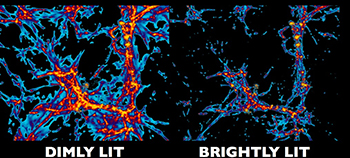
Left: Observed astronomical sources of UV light produce a simulated map of “dimly lit” neutral hydrogen intensity in between galaxies. Right: Hubble’s data produce a “brightly lit” map, in which more UV photons cause more splitting and destruction of neutral hydrogen. Credit: Ben Oppenheimer and Juna Kollmeier
An international team of astronomers has concluded that the modeling of intergalactic hydrogen and the light associated with it is vastly mismatched and may require new ways of thinking about the universe (Ap. J., DOI: 10.1088/2041-8205/789/2/L32). Cosmologist Juna Kollmeier at the Carnegie Observatories, U.S.A, and colleagues combined observations of the intergalactic medium with observations of known populations of galaxies and quasars to determine that these light sources are not producing nearly enough ultraviolet (UV) light to account for the observed tendrils of ionized hydrogen and helium in the vast reaches of space between galaxies.
The difference is a whopping factor-of-five discrepancy between the metagalactic photionization rate, called ΓHI, predicted by the most accurate models of ultraviolet background evolution, and the value required to produce the observed light.
“It’s like going outside in the middle of the night and getting a sunburn,” said Kollmeier. “Where are these photons coming from?”
New observations from the Hubble Space Telescope’s Cosmic Origins Spectrograph in conjunction with refined estimates of the cosmic UV background evolution motivated astronomers to reassess the local intergalactic medium. Applying these improvements in supercomputer simulations, Kollmeier and colleagues in the United States, Italy and South Africa found that the effective column density distribution of the observed Lyman-α forest (absorption lines in the spectra of distant quasars and galaxies caused by neutral hydrogen) is 400 percent higher than expected. Termed the “photon underproduction crisis,” the mismatch isn’t evident in far away observations of the early universe; it’s only a problem when telescopes look at nearby intergalactic space closer to the Milky Way.
The group proposes that either conventional sources of ionizing photons such as galaxies and quasars may have a much greater impact than predicted on the diffuse radiation found between galaxies, or cosmological models may be in need of substantial revision.
